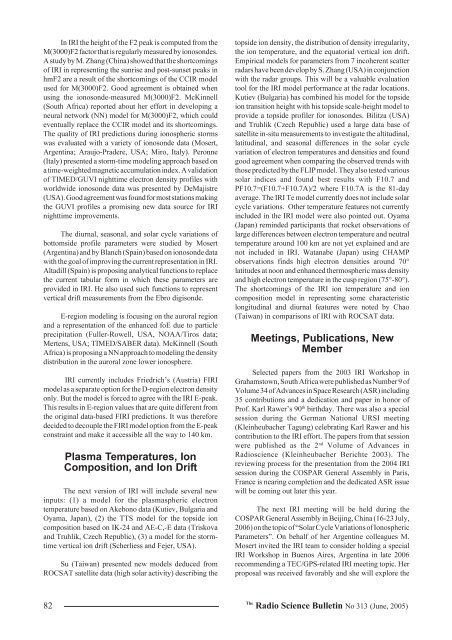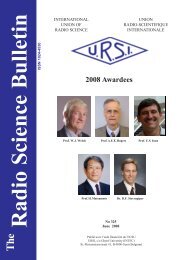Radio Science Bulletin 313 - June 2005 - URSI
Radio Science Bulletin 313 - June 2005 - URSI
Radio Science Bulletin 313 - June 2005 - URSI
- No tags were found...
Create successful ePaper yourself
Turn your PDF publications into a flip-book with our unique Google optimized e-Paper software.
In IRI the height of the F2 peak is computed from theM(3000)F2 factor that is regularly measured by ionosondes.A study by M. Zhang (China) showed that the shortcomingsof IRI in representing the sunrise and post-sunset peaks inhmF2 are a result of the shortcomings of the CCIR modelused for M(3000)F2. Good agreement is obtained whenusing the ionosonde-measured M(3000)F2. McKinnell(South Africa) reported about her effort in developing aneural network (NN) model for M(3000)F2, which couldeventually replace the CCIR model and its shortcomings.The quality of IRI predictions during ionospheric stormswas evaluated with a variety of ionosonde data (Mosert,Argentina; Araujo-Pradere, USA; Miro, Italy). Peronne(Italy) presented a storm-time modeling approach based ona time-weighted magnetic accumulation index. A validationof TIMED/GUVI nighttime electron density profiles withworldwide ionosonde data was presented by DeMajistre(USA). Good agreement was found for most stations makingthe GUVI profiles a promising new data source for IRInighttime improvements.The diurnal, seasonal, and solar cycle variations ofbottomside profile parameters were studied by Mosert(Argentina) and by Blanch (Spain) based on ionosonde datawith the goal of improving the current representation in IRI.Altadill (Spain) is proposing analytical functions to replacethe current tabular form in which these parameters areprovided in IRI. He also used such functions to representvertical drift measurements from the Ebro digisonde.E-region modeling is focusing on the auroral regionand a representation of the enhanced foE due to particleprecipitation (Fuller-Rowell, USA, NOAA/Tiros data;Mertens, USA; TIMED/SABER data). McKinnell (SouthAfrica) is proposing a NN approach to modeling the densitydistribution in the auroral zone lower ionosphere.IRI currently includes Friedrich’s (Austria) FIRImodel as a separate option for the D-region electron densityonly. But the model is forced to agree with the IRI E-peak.This results in E-region values that are quite different fromthe original data-based FIRI predictions. It was thereforedecided to decouple the FIRI model option from the E-peakconstraint and make it accessible all the way to 140 km.Plasma Temperatures, IonComposition, and Ion DriftThe next version of IRI will include several newinputs: (1) a model for the plasmaspheric electrontemperature based on Akebono data (Kutiev, Bulgaria andOyama, Japan), (2) the TTS model for the topside ioncomposition based on IK-24 and AE-C,-E data (Triskovaand Truhlik, Czech Republic), (3) a model for the stormtimevertical ion drift (Scherliess and Fejer, USA).Su (Taiwan) presented new models deduced fromROCSAT satellite data (high solar activity) describing thetopside ion density, the distribution of density irregularity,the ion temperature, and the equatorial vertical ion drift.Empirical models for parameters from 7 incoherent scatterradars have been develop by S. Zhang (USA) in conjunctionwith the radar groups. This will be a valuable evaluationtool for the IRI model performance at the radar locations.Kutiev (Bulgaria) has combined his model for the topsideion transition height with his topside scale-height model toprovide a topside profiler for ionosondes. Bilitza (USA)and Truhlik (Czech Republic) used a large data base ofsatellite in-situ measurements to investigate the altitudinal,latitudinal, and seasonal differences in the solar cyclevariation of electron temperatures and densities and foundgood agreement when comparing the observed trends withthose predicted by the FLIP model. They also tested varioussolar indices and found best results with F10.7 andPF10.7=(F10.7+F10.7A)/2 where F10.7A is the 81-dayaverage. The IRI Te model currently does not include solarcycle variations. Other temperature features not currentlyincluded in the IRI model were also pointed out. Oyama(Japan) reminded participants that rocket observations oflarge differences between electron temperature and neutraltemperature around 100 km are not yet explained and arenot included in IRI. Watanabe (Japan) using CHAMPobservations finds high electron densities around 70°latitudes at noon and enhanced thermospheric mass densityand high electron temperature in the cusp region (75°-80°).The shortcomings of the IRI ion temperature and ioncomposition model in representing some characteristiclongitudinal and diurnal features were noted by Chao(Taiwan) in comparisons of IRI with ROCSAT data.Meetings, Publications, NewMemberSelected papers from the 2003 IRI Workshop inGrahamstown, South Africa were published as Number 9 ofVolume 34 of Advances in Space Research (ASR) including35 contributions and a dedication and paper in honor ofProf. Karl Rawer’s 90 th birthday. There was also a specialsession during the German National <strong>URSI</strong> meeting(Kleinheubacher Tagung) celebrating Karl Rawer and hiscontribution to the IRI effort. The papers from that sessionwere published as the 2 nd Volume of Advances in<strong>Radio</strong>science (Kleinheubacher Berichte 2003). Thereviewing process for the presentation from the 2004 IRIsession during the COSPAR General Assembly in Paris,France is nearing completion and the dedicated ASR issuewill be coming out later this year.The next IRI meeting will be held during theCOSPAR General Assembly in Beijing, China (16-23 July,2006) on the topic of “Solar Cycle Variations of IonosphericParameters”. On behalf of her Argentine colleagues M.Mosert invited the IRI team to consider holding a specialIRI Workshop in Buenos Aires, Argentina in late 2006recommending a TEC/GPS-related IRI meeting topic. Herproposal was received favorably and she will explore the82The<strong>Radio</strong> <strong>Science</strong> <strong>Bulletin</strong> No <strong>313</strong> (<strong>June</strong>, <strong>2005</strong>)
















